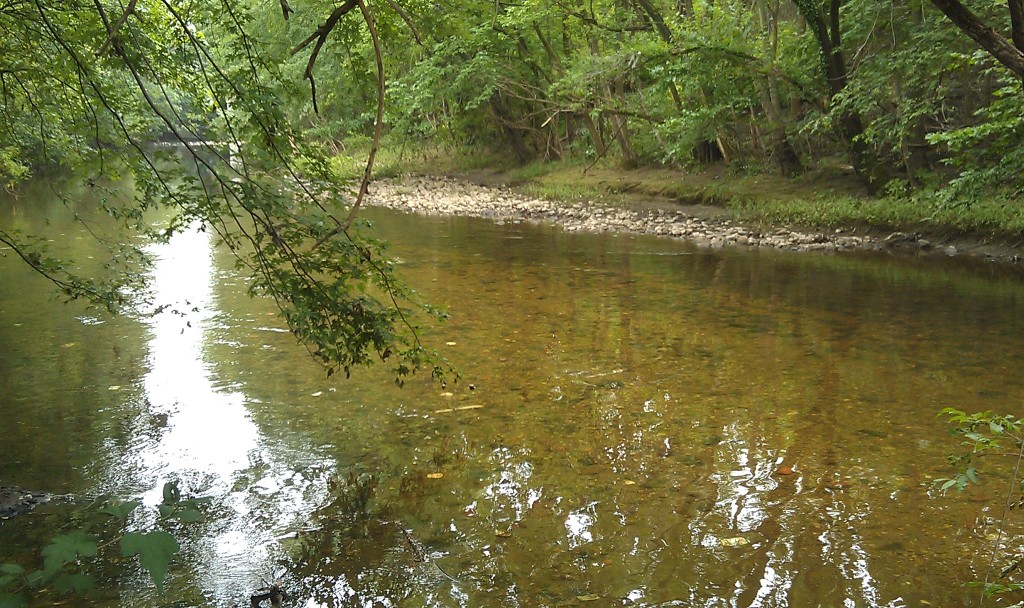Vans Warped Tour in Baltimore: It Doesn’t Take A Rock Star

The past two years, the bands, roadies, and event staff of the Vans Warped Tour have taken a day off from head-banging and face-melting to help Blue Water Baltimore in our efforts to save our streams. It was hard to top 2011’s project, where we converted more than 30,000 square feet of asphalt in Hampden into an outdoor classroom and community green space–but we did. This year on July 23rd, the Vans Warped Tour folks joined us and our partners at Baltimore City Recreation & Parks to undertake a massive cleanup of the Gwynns Falls river.
Together, the Vans Warped Tour volunteers and Blue Water Baltimore staff and partners (who are also rock stars, I should note!) removed well over 2,000 pounds of trash from one of the most heavily polluted stream reaches in the city, along the Gwynns Falls Trail at the Carroll Park Golf Course in West Baltimore.
It was their day off on a music tour that lasts a full two months, with shows in different cities every night. At 6am the buses began rolling in, and despite the fact that the van carrying their coffee and donuts was stuck behind a nasty traffic snarl some twenty miles north of Baltimore, the volunteers were in good spirits. They gamely pulled on waders and hip boots and began pulling trash out of the water. Two hours later, the 185 volunteers had nearly filled a 30-yard roll-off dumpster, yet in some places you couldn’t even tell we’d been there. Yes, the pollution is that bad.

At almost 25 miles long, the Gwynns Falls is the longest waterway that comes under our jurisdiction here at Blue Water Baltimore. The river drains an area of 66 square miles that stretches from Reisterstown to Ravens Stadium, nearly 3/4 of which is classified as urban. That’s a lot of hard surfaces (roads, roofs, parking lots) from which stormwater runs off instead of filtering back into the ground. And intentional or not, the litter of more than 400,000 people who live in the watershed…well, it adds up.
All this explains why, when it rains, the Gwynns Falls swells and overflows its banks, becoming a veritable torrent of trash. Plastic bags get stuck in tree limbs that are ten feet overhead, and underbrush is flattened by the force of the current.
And litter is not the most pressing problem the Gwynns Falls faces, only the most visible. Nutrients like nitrogen and phosphorus can cause algal blooms and fish kills, and bacteria from sanitary sewer overflows and illicit discharges present a public health threat (my own mother suffered a staph infection after launching a kayak at Canton Waterfront Park). The Gwynns Run tributary just upstream of where we were working—heavily booted and gloved, of course—brings a constant stream of the disgustingly cloudy, gray water that is a sure sign of sewage contamination.
Yet, the Gwynns Falls–despite all the challenges it faces–remains a gorgeous river. It is one of the my favorite places for hiking and biking in Baltimore, home to the 14-mile Gwynns Falls Trail and the 1200-acre Gwynns Falls/Leakin Park. It is also an urban refuge for 39 rare and endangered species. If you’ve ever walked along the river, I’m sure you’ll agree that that’s a lot worth saving.

Though rock stars CAN make a difference, it doesn’t take a Vans Warped Tour rock star to save our streams. If you are interested in helping take back our streams from trash, please email me to volunteer at one of our upcoming cleanups. We work year round to clean up pollution in our streams, and to help spread the word that trash is bad for the environment and for us. Join us for the International Coastal Cleanup on September 15th, the Better Water Ways cleanup on November 17th, or one of our other volunteer events.
I’d like to extend a huge thank-you not only to our volunteers from Vans Warped Tour, but also to our partners at Baltimore City Recreation & Parks and the Patterson Park Audubon Center, without whom this project would not have been possible.
